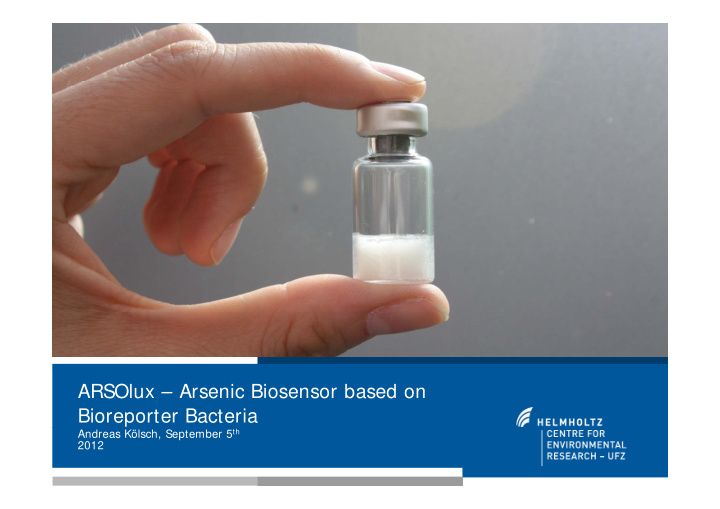



ARSOlux – Arsenic Biosensor based on Bioreporter Bacteria Andreas Kölsch, September 5 th 2012
How Does it Work? � � � � Take water sample Incubate 2 hours Measure 10 seconds Read the result: As: 8 19 µg/l As: 8.19 µg/l Light signal: red, yellow, green Drinkable: Yes/No Page 2
Field Testing Germany Saxony - Germany Saxony Page 3
Bio Sensing of CO 2 www.wvminesafety.org Page 4
As As As Signal-Gene Bio Sensing of Arsenic As Chromosome As As Page 5
Manual Calibration Samples (Measurement of four arsenic standards) Calibrators Filling of calibrators & samples into the biosensor l i t th bi vial ( (mix biosensor and sample, p two vials per sample: one undiluted, one diluted) Measurement of the light Measurement of the light emission with a luminometer (light emission corresponds to arsenic concentration) Read and store data (calculation of arsenic concentration in samples (calculation of arsenic concentration in samples based on calibration data) Page 7
Accuracy � ARSOlux calibration (field) � Cross analysis ARSOlux (with EDTA) versus ICP-MS EDTA) versus ICP-MS � Toxic inhibition > 150 µg As l -1 � Toxic inhibition > 150 µg As l Siegfried et al., 2012 Page 8
Biological vs. Conventional Advantages of ARSOlux: Material for 160 tests � Parallel measurements � Parallel measurements ARSOlux Chemical test � No toxic chemicals � Less material needed � Less material needed Challenges of ARSOlux: � Interference of Iron � Interference of Iron � GMO � Acceptance � Acceptance Siegfried et al., 2012 Page 9
Patent and Registered Trademark Page 10
Thank you for your Attention Contact: Sonja Hahn-Tomer & Andreas Kölsch Sonja Hahn Tomer & Andreas Kölsch Helmholtz Centre for Environmental Research - UFZ Permoserstraße 15 04318 Leipzig Germany Germany Phone: + + 49 341 235 1364 Fax: + + 49 341 235 1351 E-Mail: E Mail: sonja.hahn-tomer@ufz.de sonja.hahn tomer@ufz.de http://www.arsolux.ufz.de Page 11
Recommend
More recommend